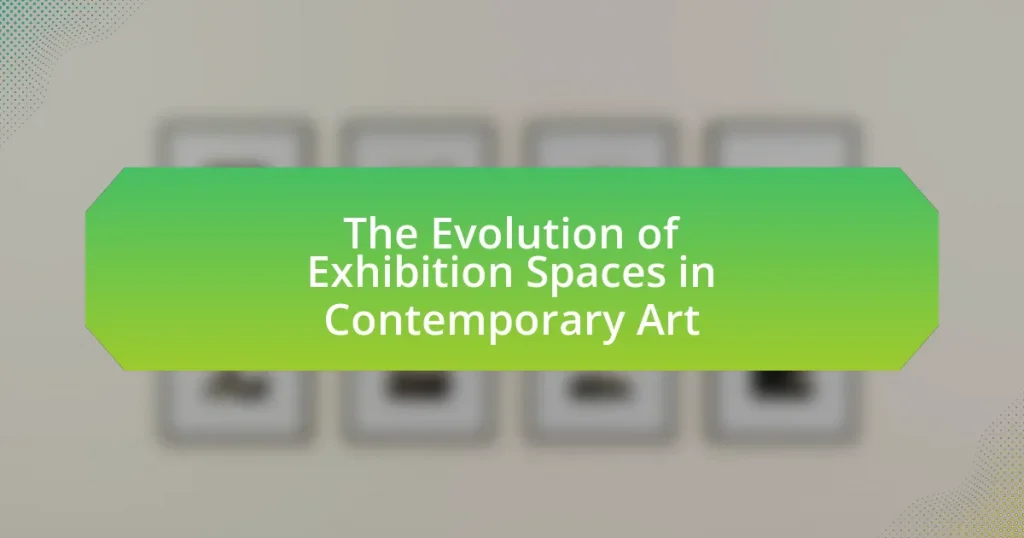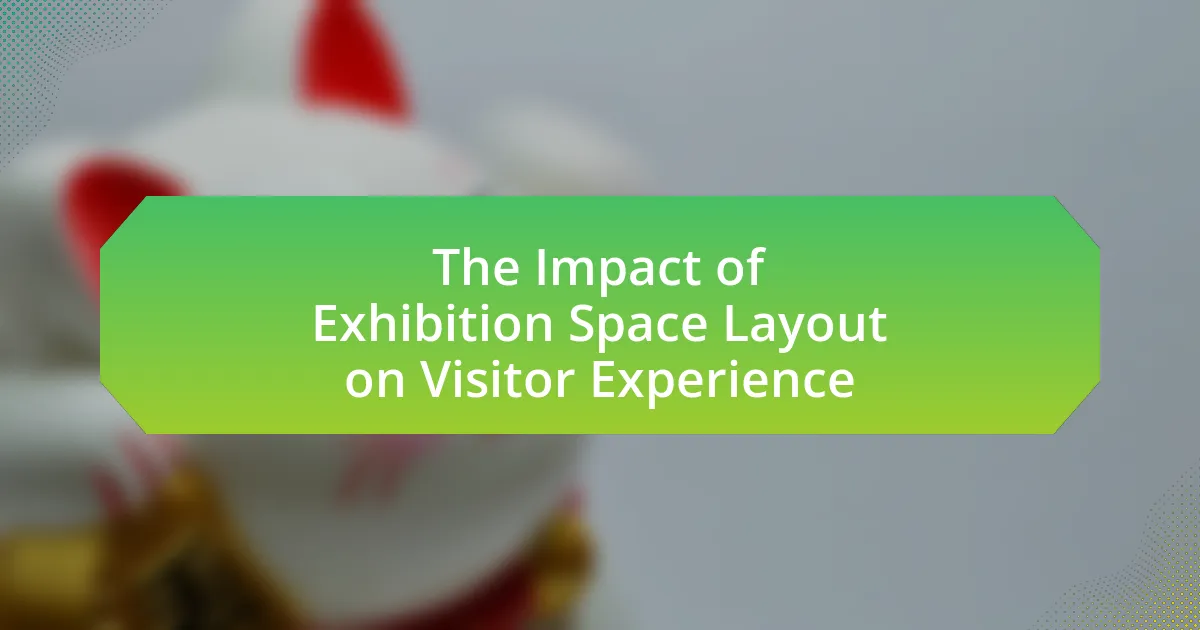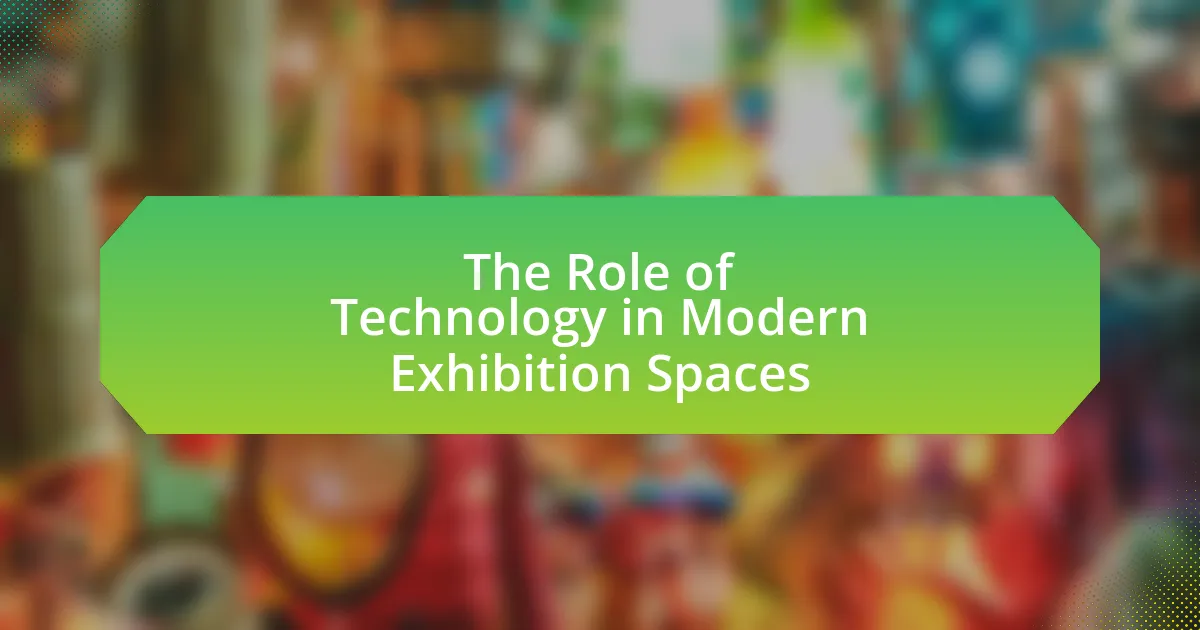The article examines the evolution of exhibition spaces in contemporary art, highlighting the transition from traditional galleries and museums to innovative, interactive environments that enhance audience engagement. It discusses historical influences on exhibition design, the impact of technological advancements, and the significance of inclusivity and community involvement in shaping these spaces. Key characteristics of contemporary exhibition spaces, such as flexibility, interactivity, and the integration of digital technology, are explored, along with emerging trends that prioritize immersive experiences and sustainability. The article emphasizes the role of curatorial practices in redefining how art is presented and experienced, ultimately reflecting broader cultural shifts in the art world.
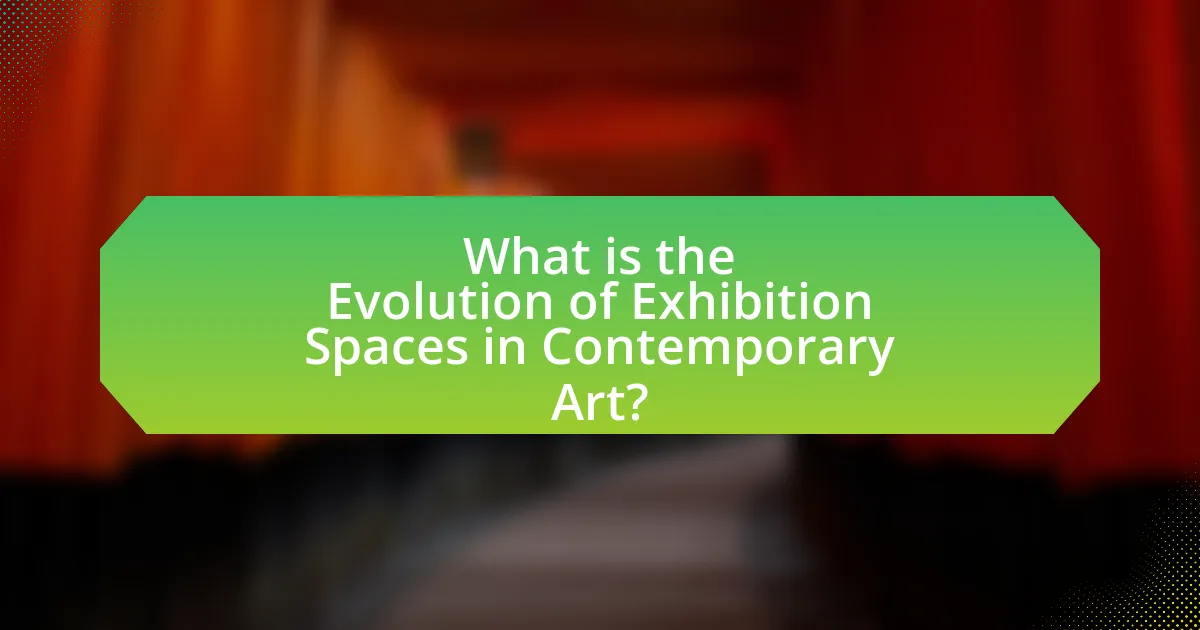
What is the Evolution of Exhibition Spaces in Contemporary Art?
The evolution of exhibition spaces in contemporary art reflects a shift from traditional gallery settings to diverse, innovative environments that engage audiences in new ways. Initially, art was primarily displayed in museums and galleries, which emphasized formal presentation and historical context. Over time, the rise of alternative spaces, such as artist-run galleries and pop-up exhibitions, emerged in the late 20th century, allowing for more experimental and community-focused approaches.
This transformation was further accelerated by technological advancements and the digital age, leading to virtual exhibitions and immersive installations that challenge conventional viewing experiences. For instance, the use of augmented reality and interactive elements has become prevalent, allowing audiences to engage with art beyond passive observation.
The increasing importance of site-specific installations also highlights how the context of a space can influence the interpretation of art. Notable examples include the Turbine Hall at Tate Modern, which has hosted large-scale installations that redefine the relationship between art and architecture.
Overall, the evolution of exhibition spaces in contemporary art demonstrates a dynamic interplay between artists, curators, and audiences, reflecting broader cultural shifts and the ongoing redefinition of what constitutes an art space.
How have exhibition spaces transformed over time?
Exhibition spaces have transformed significantly over time, evolving from traditional galleries and museums to more dynamic and interactive environments. Historically, exhibition spaces were primarily designed for static displays of art, often in formal settings that emphasized the artwork’s aesthetic value. In recent decades, however, these spaces have increasingly incorporated technology, multimedia elements, and flexible layouts to enhance visitor engagement and experience. For instance, the rise of pop-up galleries and alternative art spaces reflects a shift towards more accessible and community-oriented exhibitions, allowing for diverse artistic expressions and audience participation. This transformation is evidenced by the increasing prevalence of immersive installations and interactive exhibits in contemporary art venues, which aim to create a more participatory and inclusive atmosphere for audiences.
What historical factors influenced the design of exhibition spaces?
The design of exhibition spaces has been significantly influenced by historical factors such as the rise of museums in the 18th century, the impact of the Industrial Revolution, and the evolution of artistic movements. The establishment of public museums, like the British Museum in 1753, marked a shift towards organized spaces for art display, emphasizing accessibility and education. The Industrial Revolution introduced new materials and technologies, allowing for innovative architectural designs and larger spaces, which facilitated the display of diverse art forms. Additionally, movements such as Modernism in the early 20th century challenged traditional exhibition methods, leading to more experimental layouts that focused on viewer interaction and experience. These historical developments collectively shaped the contemporary approach to exhibition space design, prioritizing functionality, audience engagement, and artistic expression.
How did technological advancements impact exhibition spaces?
Technological advancements significantly transformed exhibition spaces by enhancing interactivity and accessibility for audiences. Innovations such as virtual reality, augmented reality, and digital displays allow for immersive experiences that engage visitors in new ways. For instance, the use of projection mapping in galleries creates dynamic environments that can change the perception of artworks, as seen in exhibitions like TeamLab Borderless in Tokyo, which utilizes digital technology to create a fluid, interactive art experience. Additionally, online platforms have expanded the reach of exhibitions, enabling global audiences to access art remotely, exemplified by the rise of virtual exhibitions during the COVID-19 pandemic. These advancements not only enrich the visitor experience but also redefine the role of curators and artists in presenting contemporary art.
Why is the evolution of exhibition spaces significant in contemporary art?
The evolution of exhibition spaces is significant in contemporary art because it reflects changes in artistic practices, audience engagement, and cultural discourse. As artists increasingly seek to challenge traditional boundaries, innovative exhibition spaces facilitate new forms of interaction and interpretation. For instance, the rise of non-traditional venues, such as warehouses and public spaces, has democratized access to art, allowing diverse audiences to engage with contemporary works outside conventional galleries. This shift is evidenced by the success of events like the Venice Biennale, which showcases a variety of artistic expressions in unique settings, thereby influencing global art trends and fostering dialogue among artists and viewers.
What role do exhibition spaces play in the art experience?
Exhibition spaces serve as critical environments that shape the art experience by providing context, facilitating engagement, and influencing interpretation. These spaces, such as galleries and museums, are designed to enhance the visibility of artworks, allowing viewers to interact with art in a curated setting that often reflects thematic or conceptual frameworks. For instance, the layout and design of an exhibition can guide the viewer’s journey, impacting emotional responses and understanding of the artwork. Research indicates that the physical environment of an exhibition can significantly affect viewer perception and engagement, as seen in studies that demonstrate how lighting, spatial arrangement, and even sound can alter the experience of art (e.g., “The Impact of Exhibition Design on Visitor Experience” by Smith et al., 2020). Thus, exhibition spaces are not merely backdrops but active participants in the art experience, shaping how art is perceived and appreciated.
How do exhibition spaces affect artist visibility and audience engagement?
Exhibition spaces significantly enhance artist visibility and audience engagement by providing a dedicated platform for showcasing artwork. These spaces, such as galleries and museums, create an environment where artists can present their work to a broader audience, facilitating exposure that may not be achievable through other means. For instance, a study by the National Endowment for the Arts found that exhibitions increase public awareness of artists, leading to higher attendance rates and greater interaction with the art. Furthermore, well-designed exhibition spaces encourage audience participation through interactive installations and curated experiences, fostering deeper connections between the artwork and viewers. This interaction not only elevates the artist’s profile but also enriches the audience’s understanding and appreciation of contemporary art.
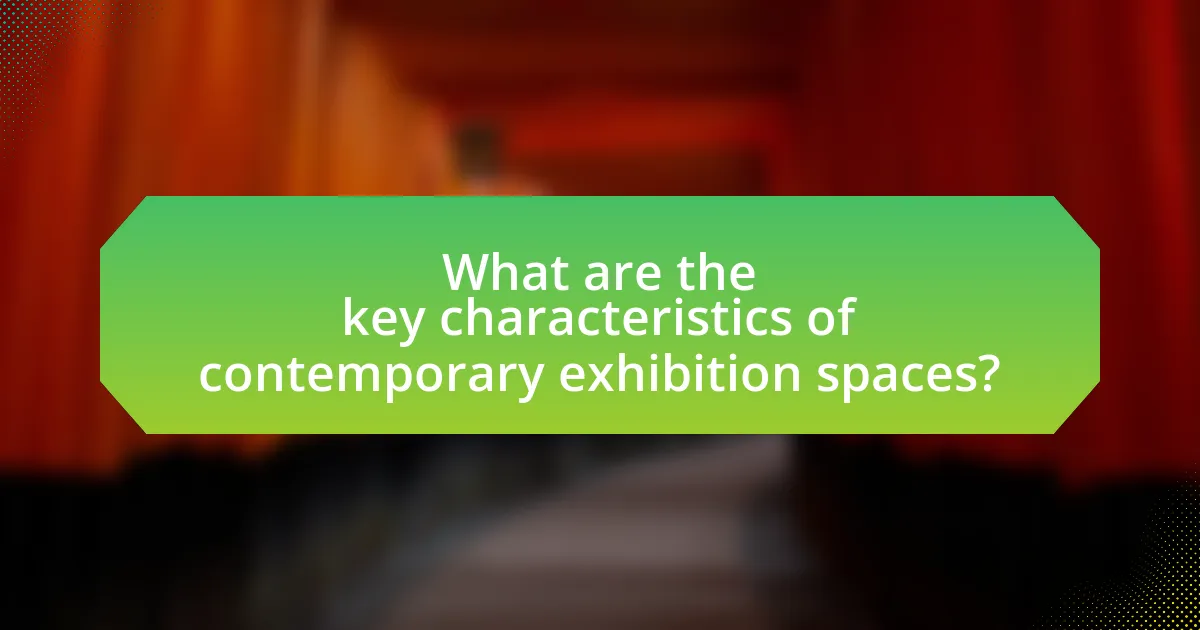
What are the key characteristics of contemporary exhibition spaces?
Contemporary exhibition spaces are characterized by flexibility, interactivity, and integration of technology. Flexibility allows these spaces to adapt to various types of art and installations, accommodating diverse artistic expressions and audience engagement. Interactivity enhances visitor experience, encouraging participation and dialogue between the artwork and the audience. The integration of technology, such as digital displays and augmented reality, creates immersive environments that redefine traditional viewing experiences. These characteristics reflect the evolving nature of art presentation and audience interaction in the contemporary art landscape.
How do contemporary exhibition spaces differ from traditional ones?
Contemporary exhibition spaces differ from traditional ones primarily in their design, purpose, and audience engagement strategies. Traditional exhibition spaces, such as museums and galleries, often feature fixed layouts and a focus on displaying artworks in a linear, didactic manner, emphasizing the art’s historical context. In contrast, contemporary spaces prioritize flexibility and interactivity, allowing for dynamic installations and immersive experiences that encourage viewer participation. For example, many contemporary art venues utilize modular designs and technology to create adaptable environments that can host various forms of art, including multimedia and performance art, which are less common in traditional settings. This shift reflects a broader trend in the art world towards inclusivity and accessibility, aiming to engage diverse audiences and foster dialogue around contemporary issues.
What design elements are commonly found in contemporary exhibition spaces?
Contemporary exhibition spaces commonly feature open layouts, flexible walls, and advanced lighting systems. Open layouts facilitate fluid movement and interaction among visitors, enhancing the overall experience. Flexible walls allow for adaptable configurations, accommodating various types of artworks and installations. Advanced lighting systems are crucial for highlighting exhibits and creating specific atmospheres, often utilizing LED technology for energy efficiency and versatility. These design elements collectively contribute to a dynamic and engaging environment that reflects the evolving nature of contemporary art.
How do contemporary exhibition spaces accommodate diverse art forms?
Contemporary exhibition spaces accommodate diverse art forms by integrating flexible layouts, advanced technology, and interdisciplinary approaches. These spaces often feature movable walls and adaptable lighting systems, allowing curators to create customized environments that suit various artistic mediums, from traditional paintings to immersive installations. For instance, institutions like the Tate Modern in London utilize open floor plans that facilitate the display of large-scale sculptures and multimedia works, demonstrating their commitment to showcasing a wide range of artistic expressions. Additionally, many contemporary galleries incorporate digital tools, such as virtual reality and augmented reality, to enhance viewer engagement and broaden the scope of artistic representation. This adaptability not only reflects the evolving nature of art but also fosters inclusivity by providing platforms for underrepresented artists and innovative practices.
What trends are shaping the future of exhibition spaces in contemporary art?
Trends shaping the future of exhibition spaces in contemporary art include increased integration of technology, a focus on immersive experiences, and a shift towards community engagement. The integration of technology, such as augmented reality and virtual reality, enhances viewer interaction and engagement, allowing for dynamic presentations of art. Immersive experiences are becoming central, as exhibitions aim to create environments that envelop the audience, fostering deeper emotional connections with the artwork. Additionally, contemporary art spaces are increasingly prioritizing community involvement, with many galleries and museums hosting participatory events and workshops that encourage local engagement and collaboration. These trends reflect a broader movement towards inclusivity and accessibility in the art world, responding to changing audience expectations and societal shifts.
How is sustainability influencing the design of exhibition spaces?
Sustainability is significantly influencing the design of exhibition spaces by prioritizing eco-friendly materials and energy-efficient technologies. Designers are increasingly incorporating renewable resources, such as bamboo and recycled metals, to minimize environmental impact. For instance, the use of LED lighting reduces energy consumption by up to 75% compared to traditional lighting, thereby lowering the carbon footprint of exhibitions. Additionally, many exhibition spaces are now designed with modular components that can be reused or repurposed, further promoting sustainability. This shift not only aligns with global environmental goals but also meets the growing demand from audiences for responsible and ethical practices in the arts.
What role does digital technology play in modern exhibition spaces?
Digital technology serves as a transformative force in modern exhibition spaces by enhancing visitor engagement and facilitating interactive experiences. This integration allows for dynamic displays, such as augmented reality and virtual reality installations, which create immersive environments that captivate audiences. For instance, the use of projection mapping can turn static artworks into animated experiences, significantly increasing viewer interaction and emotional connection. Furthermore, data analytics tools enable curators to understand visitor behavior and preferences, optimizing exhibition layouts and content for better accessibility and enjoyment. These advancements illustrate how digital technology not only modernizes the presentation of art but also enriches the overall experience for visitors, making exhibitions more relevant and impactful in today’s digital age.
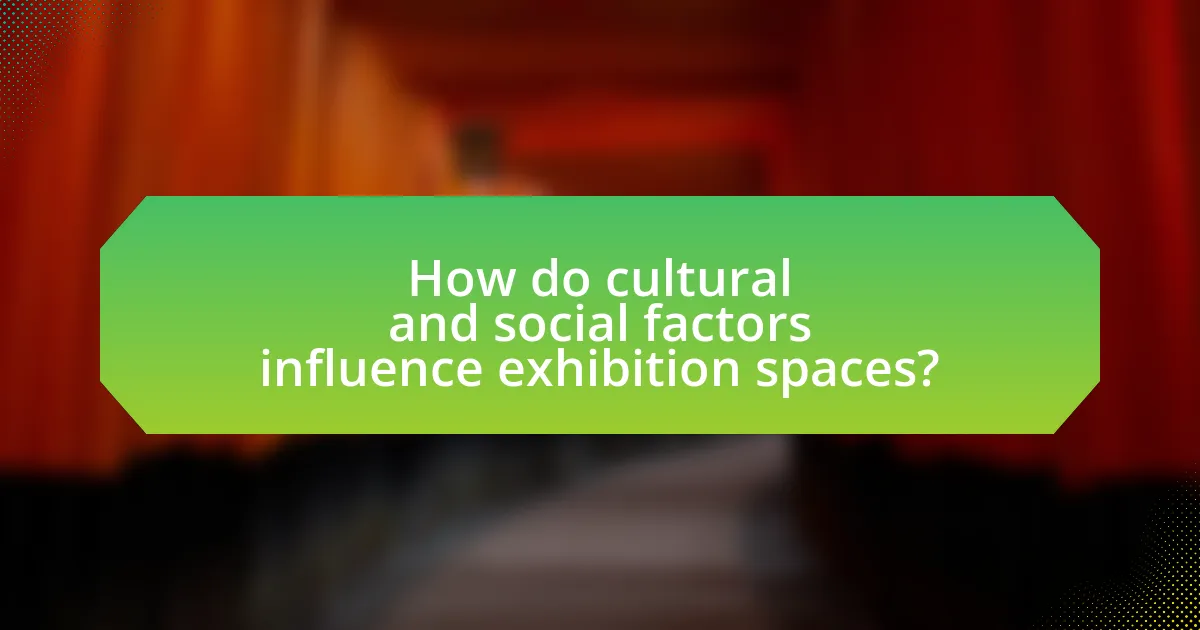
How do cultural and social factors influence exhibition spaces?
Cultural and social factors significantly influence exhibition spaces by shaping their design, accessibility, and the types of artworks displayed. For instance, cultural norms dictate the themes and narratives that resonate with specific audiences, leading curators to select works that reflect local traditions or contemporary societal issues. Social factors, such as community demographics and economic conditions, affect the physical layout and accessibility of these spaces, ensuring they cater to diverse populations. Research indicates that exhibitions designed with community input tend to attract larger audiences and foster greater engagement, as seen in initiatives like the “Community Curators” program in various museums, which emphasizes local voices in the curation process.
What impact do cultural contexts have on the design of exhibition spaces?
Cultural contexts significantly influence the design of exhibition spaces by shaping the aesthetic, functional, and interpretive elements of the environment. For instance, cultural heritage can dictate the materials used, the layout of the space, and the types of artworks displayed, ensuring that they resonate with local traditions and values. Research indicates that exhibition spaces designed with cultural sensitivity enhance visitor engagement and understanding; for example, the Museum of Contemporary Art in Sydney incorporates Indigenous Australian perspectives in its design, fostering a deeper connection between the artworks and the community. This alignment with cultural contexts not only enriches the visitor experience but also promotes inclusivity and relevance in contemporary art exhibitions.
How do community needs shape the functionality of exhibition spaces?
Community needs significantly shape the functionality of exhibition spaces by influencing their design, programming, and accessibility. Exhibition spaces are increasingly tailored to reflect the interests and demographics of the local population, ensuring that the art presented resonates with community values and cultural narratives. For instance, research by the National Endowment for the Arts indicates that community engagement in the arts leads to increased attendance and participation, demonstrating that spaces that prioritize local input are more successful in attracting diverse audiences. Additionally, the incorporation of flexible layouts and multifunctional areas allows these spaces to host a variety of events, workshops, and performances that cater to community preferences, further enhancing their relevance and utility.
What are the implications of inclusivity in contemporary exhibition spaces?
Inclusivity in contemporary exhibition spaces enhances accessibility and representation, fostering a diverse audience engagement. By integrating various perspectives and backgrounds, these spaces challenge traditional narratives and promote a broader understanding of art. Research indicates that inclusive practices can increase visitor numbers by up to 30%, as seen in institutions that actively implement community outreach and diverse programming. This shift not only enriches the cultural dialogue but also aligns with contemporary societal values, making art more relevant and impactful.
How do curatorial practices affect the evolution of exhibition spaces?
Curatorial practices significantly influence the evolution of exhibition spaces by shaping how art is presented and experienced. These practices determine the thematic organization, spatial arrangement, and audience engagement strategies within galleries and museums. For instance, the rise of immersive and interactive exhibitions reflects curators’ responses to contemporary audience expectations, leading to the redesign of traditional exhibition layouts into more dynamic environments. This shift is evidenced by the increasing popularity of exhibitions that incorporate technology and participatory elements, such as the “teamLab Borderless” exhibition in Tokyo, which utilizes digital art to create an engaging, fluid space that encourages visitor interaction. Such developments illustrate how curatorial decisions directly impact the physical and conceptual frameworks of exhibition spaces, driving their evolution in response to cultural trends and audience needs.
What are the emerging curatorial strategies in contemporary exhibitions?
Emerging curatorial strategies in contemporary exhibitions include participatory practices, interdisciplinary approaches, and the integration of digital technologies. Participatory practices engage audiences directly, allowing them to contribute to the exhibition’s content and experience, which fosters a sense of community and ownership. Interdisciplinary approaches break down traditional boundaries between art forms, encouraging collaborations between artists, scientists, and technologists, thereby enriching the narrative and context of the artworks. The integration of digital technologies, such as virtual reality and augmented reality, enhances visitor engagement and expands the possibilities of how art is experienced, making exhibitions more accessible and interactive. These strategies reflect a shift towards inclusivity and innovation in the presentation of contemporary art.
How do curators utilize space to enhance the viewer’s experience?
Curators utilize space to enhance the viewer’s experience by strategically designing layouts that guide movement and interaction. This approach includes the arrangement of artworks to create visual pathways, allowing viewers to engage with pieces in a meaningful sequence. For example, the use of open spaces can foster a sense of exploration, while intimate settings can encourage contemplation. Additionally, curators often incorporate lighting and sound to create immersive environments that heighten emotional responses. Research indicates that well-planned spatial design can significantly impact viewer engagement and satisfaction, as seen in exhibitions like the Tate Modern’s Turbine Hall, where the vast space invites large-scale installations that captivate audiences.
What practical considerations should be taken into account when designing exhibition spaces?
When designing exhibition spaces, practical considerations include spatial layout, lighting, accessibility, and visitor flow. Spatial layout must accommodate the artworks and allow for optimal viewing angles, ensuring that each piece is highlighted effectively. Lighting is crucial, as it can enhance or detract from the artwork; natural light should be controlled to prevent damage, while artificial lighting should be adjustable to suit different exhibits. Accessibility is essential to ensure that all visitors, including those with disabilities, can navigate the space comfortably. Visitor flow should be planned to minimize congestion and enhance the overall experience, often utilizing pathways that guide attendees through the exhibition logically. These considerations are supported by studies indicating that well-designed exhibition spaces can significantly improve visitor engagement and satisfaction.
How can designers balance aesthetics and functionality in exhibition spaces?
Designers can balance aesthetics and functionality in exhibition spaces by integrating visual appeal with practical design elements that enhance visitor experience. This involves creating layouts that are not only visually striking but also facilitate movement and interaction, ensuring that artworks are displayed effectively while allowing for easy navigation. For instance, the use of modular design can provide flexibility in space usage, accommodating various types of exhibitions while maintaining an engaging aesthetic. Research indicates that well-designed exhibition spaces can increase visitor engagement by up to 30%, demonstrating the importance of this balance in enhancing the overall impact of contemporary art exhibitions.
What are best practices for creating engaging exhibition environments?
Best practices for creating engaging exhibition environments include designing interactive spaces, utilizing diverse media, and ensuring clear navigation. Interactive spaces encourage visitor participation, which enhances engagement; for example, installations that allow visitors to touch or manipulate elements can create memorable experiences. Utilizing diverse media, such as video, sound, and digital displays, caters to different learning styles and keeps the audience’s attention. Clear navigation through well-defined pathways and signage helps visitors easily explore the exhibition, reducing confusion and enhancing their overall experience. Research indicates that exhibitions incorporating these elements see increased visitor satisfaction and retention, as evidenced by studies conducted by the American Alliance of Museums, which highlight the importance of visitor engagement in contemporary art exhibitions.
